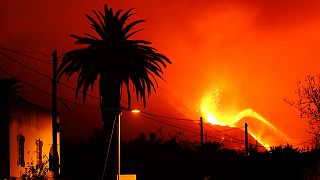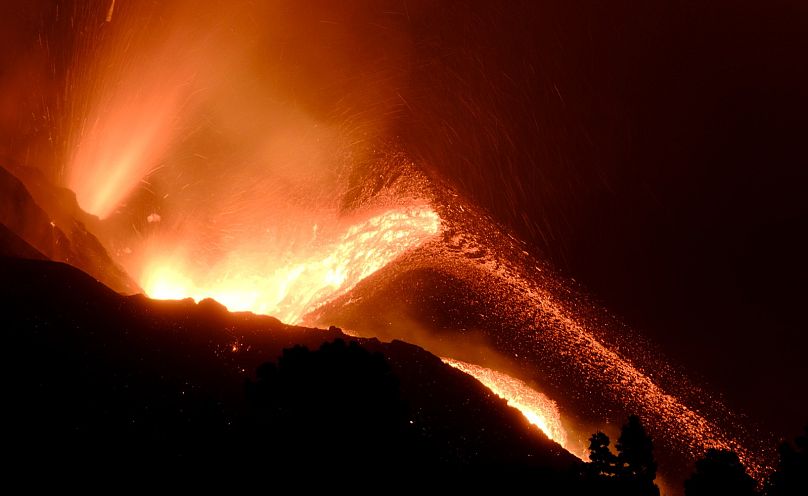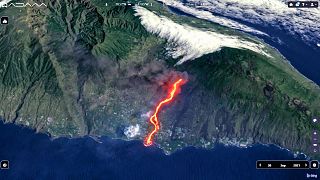PELE GROWS GAIA'S SURFACE
La Palma: New lava streams after volcano's cone collapses By AP • Updated: 11/10/2021 - 12:04

A volcano continues to spew out lava on the Canary island of La Palma, Spain in the early hours of Sunday, Oct. 10, 2021. - Copyright AP Photo/Daniel Roca
Three weeks since its eruption upended the lives of thousands, the volcano on Spain’s La Palma island is still spewing out endless streams of lava with no signs of ceasing.
Authorities on Sunday monitored a new stream of molten rock that has added to the destruction of over 1,100 buildings.
The collapse on Saturday of part of the volcanic cone sent a flood of bright red lava pouring down from the Cumbre Vieja ridge that initially cracked open on September 19.
The fast-flowing stream carried away huge chunks of lava that had already hardened. An industrial park was soon engulfed.
“We cannot say that we expect the eruption that began 21 days ago to end anytime soon,” said Julio Pérez, the regional minister for security on the Canary Islands.
La Palma is part of Spain’s Canary Islands, an Atlantic Ocean archipelago off northwest Africa whose economy depends on the cultivation of the Canary plantain and tourism.
The new rivers of lava have not forced the evacuation of any more residents since they are all so staying within the exclusion zone that authorities have created. Some 6,000 residents were promptly evacuated after the initial eruption.
Government experts estimated that the largest of the lava flows measures 1.5 km at its widest point, while the delta of new land being formed where lava is flowing into the Atlantic has reached a surface of 34 hectares.

A volcano continues to spew out lava on the Canary island of La Palma, Spain in the early hours of Sunday, Oct. 10, 2021.AP Photo/Daniel Roca
The scientific committee advising the government said that if the delta continues to grow outwards into the sea, parts of it could break off. That would generate explosions, gas emissions and large waves, committee spokeswoman José María Blanco said, but should not represent a danger to those outside the no-go zone.
The Canary Islands' tourism industry was already hard hit by the pandemic, and officials were urging tourists not to keep staying away.
“This eruption is impacting a part of the island, but La Palma is still a safe place and can offer a lot to those who visit,” said Mariano Hernández, the island’s leading authority.
The last eruption on La Palma 50 years ago lasted just over three weeks. The last eruption on all the Canary Islands occurred underwater off the coast of El Hierro island in 2011 and lasted five months.
The scientific committee advising the government said that if the delta continues to grow outwards into the sea, parts of it could break off. That would generate explosions, gas emissions and large waves, committee spokeswoman José María Blanco said, but should not represent a danger to those outside the no-go zone.
The Canary Islands' tourism industry was already hard hit by the pandemic, and officials were urging tourists not to keep staying away.
“This eruption is impacting a part of the island, but La Palma is still a safe place and can offer a lot to those who visit,” said Mariano Hernández, the island’s leading authority.
The last eruption on La Palma 50 years ago lasted just over three weeks. The last eruption on all the Canary Islands occurred underwater off the coast of El Hierro island in 2011 and lasted five months.
La Palma volcano: Satellite image shows lava flow to Atlantic Ocean
By Euronews with AP, AFP • Updated: 04/10/2021

The lava flow from the Cumbre Vieja volcano on the Spanish island of La Palma,
By Euronews with AP, AFP • Updated: 04/10/2021

The lava flow from the Cumbre Vieja volcano on the Spanish island of La Palma,
on Sept. 30, 2021. - Copyright Copernicus Sentinel / Adam Platform
The volcano on La Palma in Spain's Canary Islands blew open a new fissure on Friday, triggering a series of small earthquakes.
Authorities said they have recorded eight new earthquakes up to magnitude 3.5.
They were waiting to see whether lava from the new fissure would join the main flow, which has travelled six kilometres and reached the Atlantic Ocean, shown in the satellite image, above.
The molten rocks have solidified upon contact with the seawater, creating a kind of peninsula.
On Thursday afternoon, the surface area of this expansion was approaching 19 hectares, compared with 10 at the beginning of the morning, David Calvo, spokesman for the Volcanological Institute of the Canary Islands (Involcan) said.
Experts have warned it is likely to have a devastating short-term impact on the local marine ecosystem.
The meeting of lava and water has also produce potentially toxic gases.
Officials were monitoring air quality along the shoreline and although sulfur dioxide levels in the area rose, they do not represent a health threat, La Palma’s government said.
However, it advised local residents to stay indoors. It also recommended that people on the island wear face masks and eye protection against heavy falls of volcanic ash.
There have been no reported injuries or death since the September 19 eruption.
The lava has so far hit more than 1,000 buildings, including homes and farming infrastructure, and entombed around 338 hectares (835 acres).
La Palma, home to about 85,000 people who live mostly from fruit farming and tourism, is part of the volcanic Canary Islands, an archipelago off northwest Africa that is part of Spain's territory.
The island is roughly 35 kilometres (22 miles) long and 20 kilometres (12 miles) wide at its broadest point. Life has continued as usual on most of the island while the volcano is active.
The two previous eruptions in La Palma took place in 1949 and 1971. They caused a total of three deaths, two of which were due to gas inhalation.
The volcano on La Palma in Spain's Canary Islands blew open a new fissure on Friday, triggering a series of small earthquakes.
Authorities said they have recorded eight new earthquakes up to magnitude 3.5.
They were waiting to see whether lava from the new fissure would join the main flow, which has travelled six kilometres and reached the Atlantic Ocean, shown in the satellite image, above.
The molten rocks have solidified upon contact with the seawater, creating a kind of peninsula.
On Thursday afternoon, the surface area of this expansion was approaching 19 hectares, compared with 10 at the beginning of the morning, David Calvo, spokesman for the Volcanological Institute of the Canary Islands (Involcan) said.
Experts have warned it is likely to have a devastating short-term impact on the local marine ecosystem.
The meeting of lava and water has also produce potentially toxic gases.
Officials were monitoring air quality along the shoreline and although sulfur dioxide levels in the area rose, they do not represent a health threat, La Palma’s government said.
However, it advised local residents to stay indoors. It also recommended that people on the island wear face masks and eye protection against heavy falls of volcanic ash.
There have been no reported injuries or death since the September 19 eruption.
The lava has so far hit more than 1,000 buildings, including homes and farming infrastructure, and entombed around 338 hectares (835 acres).
La Palma, home to about 85,000 people who live mostly from fruit farming and tourism, is part of the volcanic Canary Islands, an archipelago off northwest Africa that is part of Spain's territory.
The island is roughly 35 kilometres (22 miles) long and 20 kilometres (12 miles) wide at its broadest point. Life has continued as usual on most of the island while the volcano is active.
The two previous eruptions in La Palma took place in 1949 and 1971. They caused a total of three deaths, two of which were due to gas inhalation.
No comments:
Post a Comment